Top 7 Best Drum Mic Kits
We may also earn commissions on purchases from other retail websites.
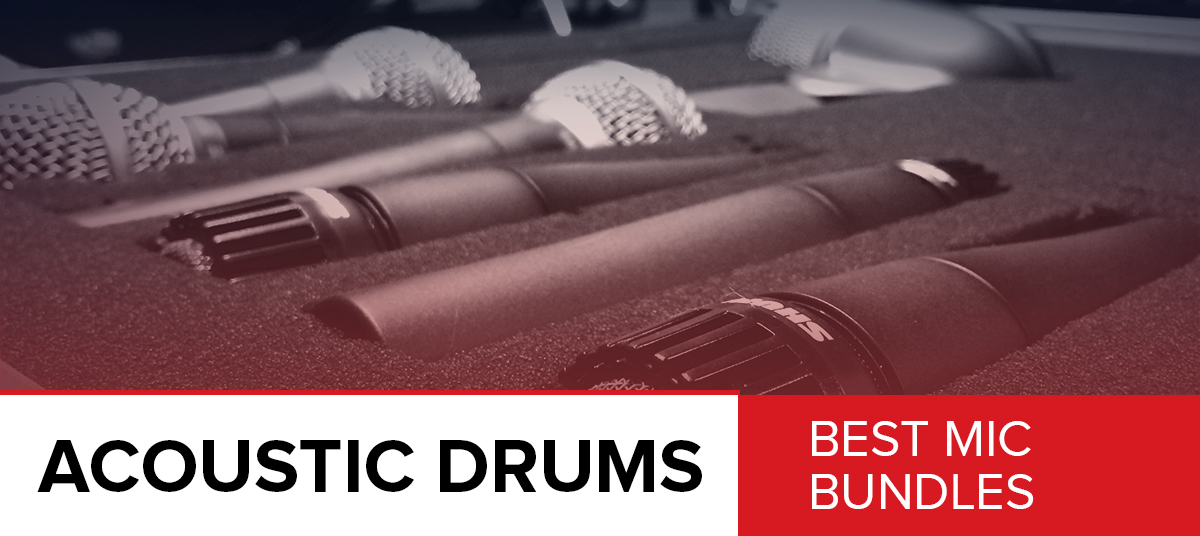
There are several ways to record drums right now. Some are more complex than others but none of them are as thorough as using dedicate drum mic kits. These simply offer the best flexibility and allow you to push your gear to its limits. Today we are going to show you our picks for the top 7 bet drum mic kits on the market. Some of these are definitely used in pro studios to record the best drum kits currently available out there. Afterward, we will talk about the use of mic kits and how to choose the right one.
Top 7 Best Drum Mic Kits:
| Image | Overhead Drum Mics / Rating | Summary | Check Price |
|---|---|---|---|
+ - 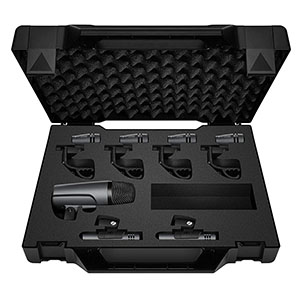 | Sennheiser Instrument Dynamic Microphone Total of 4.85/5 | By far one of the most capable dynamic kits on the market. | |
+ - 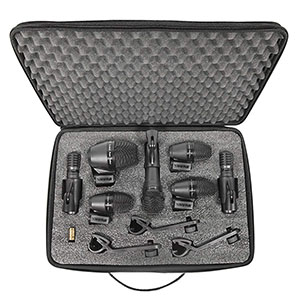 | Shure PGADRUMKIT7 Total of 4.83/5 | An awesome hybrid kit that includes both condensers and dynamic Shure models. | |
+ - 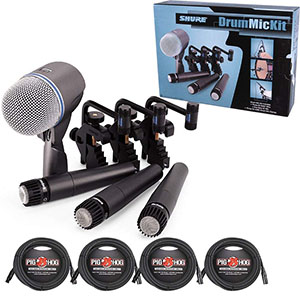 | Shure DMK57-52 Total of 4.70/5 | A simple, more traditional Shure package that inspires plenty of confidence overall. | |
+ - 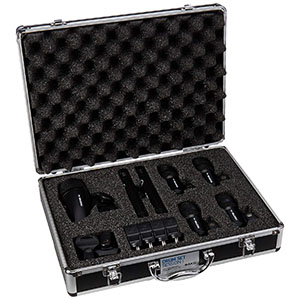 | AKG Drum Set Session Total of 4.63/5 | One of more popular value packs coming from none other than AKG. | |
+ - 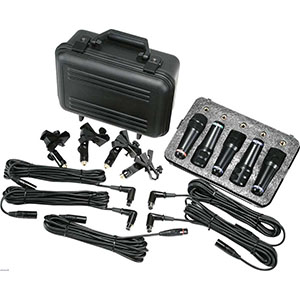 | Peavey Drum Microphone Kit Total of 4.43/5 | A great kit which doesn't break the bank but does the job. | |
+ - 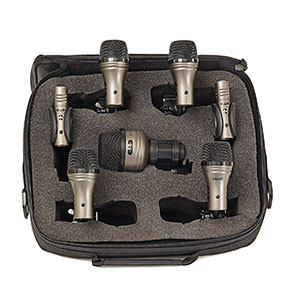 | CAD Pro-7 Total of 4.38/5 | One of the best and most versatile budget options on the market. |
Sennheiser Instrument Dynamic Microphone

| Design: |  |
| Features: |  |
| Sound: |  |
| Value: |  |
This is definitely one of the best kits on the market right now. Sennheiser's e600 series of dynamic mics are known for their rugged chassis, great features and overall performance. Getting a mix of 7 of them only adds to that experience. This particular kit includes a single e602-II, four e604 and two e614. All of these are neatly packed in a custom made case which is where you'll find mounts for all of them. What all of these mics have in common is a very robust voice coil, incredibly fast response and great isolation. This kit isn't exactly affordable, but it's worth every penny you invest in it. Especially if you insist on rendering fine details in your mix.
Shure PGADRUMKIT7

| Design: |  |
| Features: |  |
| Sound: |  |
| Value: |  |
Shure is one brand that has absolute authority when it comes to microphones, especially dynamic ones. That is why their PGADrumKit7 is regarded as one of the best bang for the buck options currently available on the market. As the name states you are getting 7 different microphones including 1 PGA52, 3 PGA56, 1 PGA57 and 2 PGA81s .It's worth noting that PGA 81 is a cardioid condenser where the rest of the mics are cardioid dynamic designs. All of these come with their own rim mounts, mic clips and 15 feet of XLR cables. The use of both dynamic and cardioid designs adds a nice balance to the performance of this kit. It's definitely a great choice for anyone.
Shure DMK57-52

| Design: |  |
| Features: |  |
| Sound: |  |
| Value: |  |
Our next pick also comes from Shure but this time we are looking at a 4-piece package. In many ways this is a more traditional kit considering that it comes with 3 Shure SM57 and a single Shure Beta 52A. On top of that you are also getting 3 of their A56D mounting clips which have proven to be pretty reliable in the past. Naturally, there are also four XLR cables to accompany the mics. What really makes this package so awesome is the fact that it include those legendary SM57s. Sure they aren't in their traditional format, but these mics are legendary just inspire confidence. Their performance is well known to just about any sound engineer on the planet.
AKG Drum Set Session

| Design: |  |
| Features: |  |
| Sound: |  |
| Value: |  |
AKG's mic kits are every bit as dependable and reliable as their overhead mics. This particular kit includes four P4 designed for use with snares and toms, 2 P17 which serve as overhead mics and a single P2 which is meant to cover the bass drum. The whole kit comes packed in a nice suitcase and includes both mounts and mounting clips. As far as performance goes, this kit is one of the easiest to work with. There is so much room for experimentation but also not a lot of room for error. The response you get is awesome, as is the overall sound. The only thing that's missing here are cables but at this price we can forgive that.
Peavey Drum Microphone Kit

| Design: |  |
| Features: |  |
| Sound: |  |
| Value: |  |
Peavey usually isn't the first brand that comes to mind when you think of microphones. However, they offer a great set of drum recording mics which come at a more than reasonable price. This kit includes a single PVM 325 snare mic and three PVM 328 tom mounted mics. All of the mics come with their dedicated clip mounts and XLR cables. It is worth noting that Peavey included 90 degrees angled XLR connectors on four cables while the fifth one is a standard straight unit. This makes mounting and hooking everything up much easier. As far as performance goes, these mics do a solid job. They offer a decent frequency response range and max 140 dB of max SPL.
CAD Pro-7

| Design: |  |
| Features: |  |
| Sound: |  |
| Value: |  |
Finding good mic kits on a budget is often seen as a very tricky task. That is only normal considering that you're trying to find multiple mics at a cheap price. However, tricky doesn't necessarily mean impossible. With brands such as CAD and kits such as Pro-7, you're pretty much presented with viable options for recording drums on a budget. This particular kit includes one KM212 kick drum mic, three TM211 dynamic tom mics, one SN210 snare mic and two CM217 condensers for overhead use. All of these come with built in mounts and clips neatly packed in well padded soft case. The overall quality if sound is more than decent, especially considering the price. This kit is a bargain.
Recording Drums and The Why Mic Kits Are Necessary
Recording drums isn't as easy as recording guitars or other popular instruments. Not only can't you plug them in, but there is more than one source of sound. An average drum set can have anywhere from 5 to 20 components all of which produce sound. That alone presents a pretty complex problem. The only real way to record drums is to use microphones. There are two tiers of drum recording methods. If you are on a budget or simply don't want to bother with the whole process too much, you can always use overhead drum microphones and record the entire set with one or two mics positioned above the set.
This method works great in most cases. However, what if you just got your brand new $2000 drum set and really want to capture the fine detail of those new shells? In that case you will have to resort to the second recording method available, which includes mic kits. Microphones kits simply make sense. Before these were available, producers had to figure out on their own which mics would work the best for each piece of the kit. While some still prefer this method, it is arguable that preset kits are more reliable on average, especially if you are just getting into music recording and production. In this part of the guide we will go deeper into what makes mic kits so great and how to properly use them.
Types of Mic Kits
Before we go any further there is one thing you should always pay attention to when shopping for a drum mic kit and that is the number of mics included. Even though this is rarely the case, a pair of microphones could technically be considered a kit. With that said, mic kits mostly include anywhere from 3 or 4 to 7 microphones. The number of mics will depend on the nature of the kit. Naturally, you will select the kit which has all of the mics you need for your particular rig. The general rule of thumb is to get a kick drum mic, snare mic and two overheads at the very least. This leads us to the components of an average mic kit.
Components of an Average Mic Kit
Now that we know how many mics generally come within a kit, lets take a look at an average component list for one of these kits. We will mostly focus on 5 piece and 7 piece kits for the sake of simplicity. A standard 5 piece kit will include a kick drum mic, three tom mics and a snare mic. All of these aside from the kick drum mic are mounted on the rim of the drum. Kick drum mic is mounted on a mic stand and positioned either inside or in front of the kick drum depending on what kind of sound you are going for.
When you step up to a 7 piece kit, you are getting all of the components we have already listed with the addition of two overhead mics. That way you can record a more complete image and add a bit of flavor to your mix. If we had to recommend one of these, we would definitely go with a 7 piece kit. It just makes more sense.
Types of Microphones Used
Recording drums can be done with both condenser and dynamic microphones depending on the way you decide to go about this. With mic kits, you will find that most of them are packed full of dynamic mics. There is a good reason for this as well. Dynamic drums are just better at handling high SPL values. We are fully aware that modern condensers are great at this too, but that thin membrane on large diaphragm condensers is generally too sensitive to handle the SPL of a drum. The volume itself isn't that much of an issue, but that aggressive attack of a drum is what causes a lot of issues with condensers. Dynamic mics on the other hand don't have that problem. That is why you will find them mounted on rims in most studios. With that said, condensers are used for overhead applications as they are much better at gathering the fine details of the whole kit.
How To Use Mic Kits?
Now that you have yourself a microphone kit, the next question that comes to mind is how to properly use these? The very first thing you will learn is that there is no fast way of doing this. You can't just mount the mics in 10 minutes and hop behind that kit to record a session. Actually, you could but chances are that your recording won't be great or even close to great. If you want to do things right, you have to understand the basics of mic positioning. Lets briefly discuss mic placement on the essential shells.
Kick Drum Mic Placement
There are two schools of thought when it comes to recording a kick drum. One says that you should put the mic just behind the outer head, while the other dictates that the mic should always be in front of said head. Former is generally considered to be the default position which is why most drums these days come with ported outer heads. However, there is some merit to both. Placing the mic inside gives you great snap and plenty of that natural attack. However, it does make the bass sound pretty sharp. Placing the mic outside takes the edge off but also captures the residual noise from the rest of the kit. Experimentation is key with kick drums.
Snare Mic Positioning
Snares are a tricky one as there are many variables to consider. On average, you will want to have a good condenser mounted on the rim of the snare and pointed at about 45 degrees into the middle of the head. This way you are guaranteed to capture that natural attack which is often associated with snare drums. Alternatively, you could point the mic toward the rim and get a more natural snare color. Also, some producers like to mount another mic at the bottom of the snare in order to catch that rattle of the snare wire.
Toms
Toms are pretty much the same as the snare. All of the same principles apply starting with the use of dynamic mics. Rim mounted mics work the best, just like with snares. Pointing the mic toward the center of the head gives you better attack while moving the focus outwards to the rim rounds things off quite nicely. One thing you need to make sure of is that your toms are tuned properly before you start working your mics.
Conclusion
Mic kits are sometimes complicated both in terms of use and setup necessary to get things going. However they have proven to be the absolute best way to record drums that we know of right now. Kits which we have shown you today are by far some of the best you can get without destroying your bank account. We have tried to find the best balance of price and performance but not at the expense of overall quality. As always, try to get the bet setup that you can afford as pre made complete kits tend to work the best.



Reader Interactions